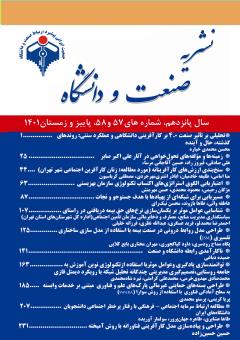طراحی مدل روابط درونی در صنعت بیمه با استفاده از مدل سازی ساختاری تفسیری (ISM)
محورهای موضوعی : عمومى
پگاه مداح رودسری
1
![]() ,
داود كيا كجوري
2
,
داود كيا كجوري
2
![]() ,
مهران مختاري بايع كلايي
3
,
مهران مختاري بايع كلايي
3
![]()
1 - دانشجوی دکتری مدیریت دولتی گرایش رفتار سازمانی؛ واحد چالوس، دانشگاه آزاد اسلامی، چالوس، ایران
2 - دانشیار گروه مدیریت دولتی؛ واحد چالوس، دانشگاه آزاد اسلامی، چالوس، ایران
3 - استادیار گروه مدیریت،واحد ابهر، دانشگاه آزاد اسلامی، ابهر، ایران
کلید واژه: سرمایه ساختاری, سرمایه انسانی, سرمایه رابطه ای, صنعت بیمه,
چکیده مقاله :
سرمایه فکری ترکیبی از دارایی های نامشهود، دارایی انسانی و زیرساخت هایی است که سازمان را در انجام وظایفش توانمند می سازد. سرمایه های ساختاری، انسانی و رابطه ای از اجزای تشکیل دهنده سرمایه فکری هستند که ترکیبی از دارایی های نامشهود، دارایی انسانی و زیرساخت هایی می باشند که سازمان را در انجام وظایفش توانمند می سازد. بر همین اساس هدف اصلی تحقیق حاضر طراحی روابط درونی بین سرمایه های ساختاری، انسانی و رابطه ای در صنعت بیمه با استفاده از مدل سازی ساختاری تفسیری (ISM) است. روش در این پژوهش کمی(توصیفی – پیمایشی) بوده و با استفاده از روش گلوله برفی 15 متخصص در حوزه مدیریت دولتی و رفتار سازمانی که در زمینه سرمایه فکری و سرمایه اجتماعی صاحب اثر بودند و در صنعت بیمه نیز سابقه مدیریتی داشته اند به عنوان نمونه آماری تحقیق انتخاب شدند که با روش مدل سازی ساختاری تفسیری (ISM) روابط درونی بین مولفه های تحقیق شناسایی شدند.
یافته های تحقیق نشان داد بُعد سرمایه انسانی (شامل مهارت های ارتباطی، تجربه کاری و دانش ضمنی افراد) به عنوان مبنای مدل بر کلیه ابعاد دیگر اثر می گذارد و در سطح زیرین قرار دارد که به عنوان پایه سرمایه فکری و عنصر اساسی در اجرای وظایف آن محسوب می شود. در سطح میانی بُعد سرمایه رابطه ای (شامل اعتماد و صداقت، مشاركت غيررسمي، مشاركت سياسي، مشارکت اجتماعی، مشاركت اقتصادي) قرار دارد و در سطح آخر نیز سرمایه ساختاری (شامل ارتباطات و پيوندهاي شبكه و سرمايه هاي شبكه) قرار دارد که دو بُعد دیگر بر آن اثر گذار هستند. در نتیجه سرمایه های ساختاری، انسانی و رابطه ای مجموعه اي از دانش، اطلاعات، دارايي هاي فكري، تجربه، رقابت و يادگيري سازماني هستند که مدیران با توجه نمودن به این عامل می توانند بستر مناسبی برای ارتقای سرمایه های فکری در سازمان فراهم نمایند.
Intellectual capital is a combination of intangible assets, human assets and infrastructures that enable the organization to perform its tasks. Structural, human, and relational capitals are the components of intellectual capital, which are a combination of intangible assets, human assets, and infrastructures that enable the organization to perform its duties. Based on this, the main goal of the current research is to design internal relationships between structural, human and relational capitals in the insurance industry using Interpretive Structural Modeling (ISM). The method in this research is quantitative (descriptive-survey) and by using the snowball method, 15 experts in the field of public administration and organizational behavior who were effective in the field of intellectual capital and social capital and also had management experience in the insurance industry as The statistical sample of the research was selected and the internal relationships between the research components were identified by the Interpretive Structural Modeling (ISM) method
The findings of the research showed that the dimension of human capital (including communication skills, work experience and tacit knowledge of people) as the basis of the model affects all other dimensions and is located at the bottom level, which is the basis of intellectual capital and an essential element. It is considered in the implementation of its duties. At the middle level of the dimension of relational capital (including trust and honesty, informal participation, political participation, social participation, economic participation) and at the last level is structural capital (including communication and network links and network capitals), which two other dimensions have an effect on it. As a result, the structural, human and relational capitals are a set of knowledge, information, intellectual assets, experience, competition and learning of the organization, which managers, paying attention to this factor, can be a suitable platform for promoting capitals. Provide an idea in the organization.
